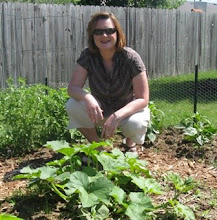First, I had to soften the tomatoes so that the seeds and skins could be removed from the tomato flesh. I took all three bags pictured here plus the ones on my counter and filled this stock pot almost to the top.

I heated the tomatoes on high heat and let them simmer just 5 minutes or so, long enough to soften them and loosen the skins. Then I ladled them into the food mill to press the juice and flesh through and separate out the skins and seeds.

Once everything had gone through the food mill, I had quite a bit of juice in my turkey roasting pan.

This was what was left over and what will feed my compost bin:

Next, I put the roasting pan of juice into a 350 degree oven for one hour. After one hour, I turned the temp down to 300 degrees for four more hours. I stirred it every half an hour to make sure it wasn't sticking. The point of doing all this was to have the water cook out and reduce the juice so that it was thick like sauce and not runny.
One hour before the sauce was done, I prepared and added the seasonings. (I'll post my recipe at the end of this post.) After the end of the total 5 hours of oven time, I took the sauce out of the oven. It smelled wonderful. Meanwhile, I had brought my boiling water bath canner full of water to a boil. I had sterilized some quart jars and had the lids and rings simmering (not boiling) on the stove for 5 minutes. When the sauce was ready, I used my funnel and ladle to fill hot quart jars with the hot sauce (remembering to remove the bay leaves first!). I wiped the rims of the jars, used tongs to put on a lid and then screw on the rings to fingertip tight. I then put them in the boiling water bath canner. All of those tomatoes had simmered down to just over 3 quarts of sauce. (I knew it would be considerably less than what I started out with, but it was still a disappointment after all that work!)
Anyway, I boiled the quart jars for 45 minutes. Then I removed them to cool. Here they are. The white powdery stuff on the outside of the jars is mineral deposits from our hard water in the boiling water bath. After the jars cool, I have to wipe that stuff off before I label them.

The good news is that there was a little bit left over so I added some chopped tomatoes and sauteed onions and garlic to it the next night and we tried it on pasta. It is really really good. The only difference I will make next time is I will decrease the amount of crushed red pepper in the recipe. It calls for 1 tsp. but I think the end result was a little too spicy for my 6yo's tastes. Jeff and the two older boys will like it, but I think next year I'll only add 1/2 tsp.
Oh, and in case you're interested, here's the recipe I used. I have to credit the folks in the Harvest Forum over at gardenweb.com with the recipe. I altered a couple of the instructions/ingredients as mentioned.
Spaghetti Sauce
4 gallons fresh roma tomatoes (yielding approx. 16 cups puree)
3 Tbsp. oil
4 cups chopped onions
3 garlic cloves, minced
1 1/2 tsp. oregano, crushed
2 bay leaves
1 Tbsp. plain salt (non-iodized)
1 Tbsp. granulated sugar
1 tsp. black pepper
1 tsp. crushed red pepper
1 Tbsp. dried parsley
1 Tbsp. celery leaves, minced (I skipped this ingredient)
1/4 c. lemon juice
Prepare tomatoes yielding approximately 16 cups of puree.
Saute onions in oil until soft and translucent. Combine with remaining ingredients except lemon juice in heavy saucepan. Simmer 2 hours stirring often until desired consistency.*
* Instead of simmering 2 hours, I roasted in the oven for one additional hour after simmering the tomato juice for 4 hours, as mentioned in my description above.
REMOVE BAY LEAVES. Pour into jars and can (as described above).
Yumm! Next year I'll need to grow more roma plants so that I have more than 3 quarts of sauce to show for it!






























